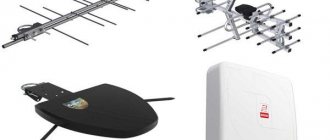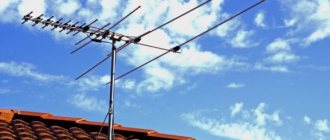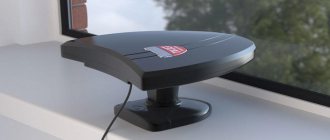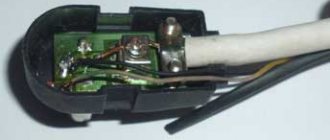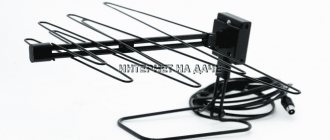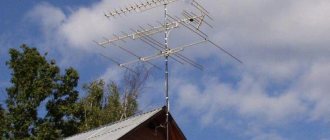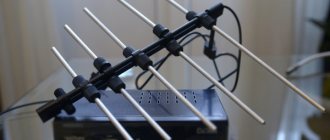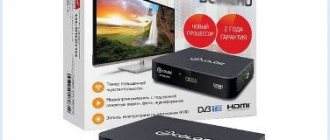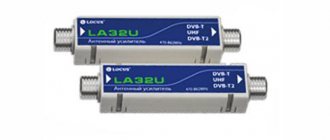Do you want to start watching T2 digital television in your country house? You will need the right antenna to receive DVB T2 digital television at your dacha. Don’t know which one to install, are there problems and uncertainties with digital television outside the city? This article is for you, because an antenna is the most effective, best way to solve these problems, and very often the only one.
If your digital television reception turns out to be poor, and you do not have practical experience to ensure good reception, then read the article carefully, and most importantly, try to follow the recommendations you have read.
Types of antennas
What is the most important thing for confident, stable reception of digital television? Antenna. It doesn’t matter where your country estate is located, to receive a digital signal you will have to work hard when choosing a television antenna for your dacha. There is no job more stupid and unnecessary than trying to receive a digital signal outside the city with an indoor antenna. Only the lucky ones will be able to watch digital television on an indoor antenna without any problems, and only if it is located in an area of reliable reception, near a TV tower or repeater.
Selenga 131F
The design of the antenna is thought out to the smallest detail, which allowed it to withstand significant wind speeds without spoiling the quality of the transmitted picture. All weak points of the antenna are reliably protected by plastic plugs that will protect it from damage. It can receive a signal in the range from 470 to 860 MHz, and will also independently amplify the signal up to 18 dB, despite the fact that the antenna does not have a built-in amplifier. The model itself belongs to the passive type. The entire set of fasteners is included, but you will have to additionally purchase cables, adapters and plugs for connecting to the TV. If you select an antenna for a dacha, which is located in a lowland, then you will definitely need an amplifier.
Pros:
- Independently amplifies the signal up to 18 dB;
- Sturdy and reliable design that can be folded;
- Special design;
- Withstands powerful winds;
- High power;
- Quality and durability;
- All fasteners are included in the kit.
Minuses:
- The kit does not include a cable or plug for connecting to a TV;
- The main rod is made of thin metal.
Active and passive analog antennas
The antenna for a TV in the country can be active or passive. If a traditional external one has a box into which the antenna cable goes, and the box itself contains a matching board (balun), then it is passive. If you are using a garden antenna with an amplifier to which power is supplied, then it is of the active type.
Power supply for amplification board 12 V 0.5 A
When and why do you need a signal amplifier? How to connect an antenna amplifier
A signal amplifier for a TV is a device that, unlike an antenna, does not receive a signal, but amplifies it. A signal amplifier is needed in cases where the TV antenna receives a signal with interference, or the signal is very weak.
If you have an amplifier, the signal will be amplified, making the image on the screen clearer. In addition, a TV with an amplifier will receive the signal without interference or distortion.
The cost of such a device depends on its type, complexity and scope of function (signal amplification, gain level adjustment, etc.). In some models, the cost starts from 1000 rubles.
Antenna for receiving digital television in the country
It's time to find out that a digital antenna for a summer residence is a marketing fiction. There are no “digital antennas”, “digital cables”, “digital amplifiers”. There are over-the-air antennas, coaxial cables, and antenna amplifiers. Their parameters and cost do not correlate in any way with either digital or analogue TV standards.
A special antenna for digital is an advertising scam. For digital TV in the country, ordinary decimeter (UHF) or broadband antennas (MF-UHF) are suitable.
And yet, what kind of antenna should I put in my dacha for long-distance reception? Multi-director at the highest possible height, precisely aimed at the broadcast tower, will give the best result. As a general rule, longer antennas with more bars (these bars are called "directors") provide much better reception than shorter ones.
Long range antenna
conclusions
- To get DVB-T2 cable television, you need to buy and install an antenna of the appropriate category, and there are several dozen models on sale that differ greatly in technical parameters and reception level.
- The following models are suitable for outdoor installation: Selenga 105A, Delta K131A.03, Harper ADVB-2969. Home models - Locus Zenit-14AF, LUMAX DA2501A, HARPER ADVB-2440.
- Powerful, productive antennas should only be purchased if you live far from digital TV towers. Otherwise, it is much more profitable to buy a less powerful device, which will still give a good picture.
- The best DVB antenna is Triton XL-LF. It is capable of amplifying the signal by 55 dB, which is convenient for remote settlements. However, it is not recommended to use it in large and medium-sized cities.
TV signal parameters
Level is an indicator of how strong the digital television signal is at the tuner input. The level is not determined by you or its seller. In the menu of any terrestrial digital tuner there is a function that shows you the signal strength.
You may be interested in: What does an HDMI cable look like?
Quality is the main indicator for which you will have to tinker with the antenna. It shows how suitable a TV signal is for digital decoding without errors. The digital tuner calculates the quality itself and can show it to you through its menu.
Signal level on the set-top box
Having set the frequency of the multiplex you need, you will see the level and quality of the signal graphically displayed on the TV screen. And then, by turning your antenna in different directions, and also installing it in different places, you can evaluate how these parameters change.
It is extremely important to correctly place the antenna in the country house. 1-2 meters in any direction and the reception can change a lot. The higher the antenna is located, the better. The further away from large metal objects, the better.
TOP 5 indoor TV antennas
Let's now look at the rating of indoor antennas with an amplifier for high-quality reception, which are most popular among Russian buyers in 2021.
Selenga 105A
Selenga 105A
A small but quite powerful indoor television antenna with a 12 dB amplifier. The design is highly ergonomic and can even be placed on a table. There is a device for adjusting the amplification power; if necessary, the amplification can be turned off (then the device will operate in passive reception mode). The only major drawback is the rather short cable, which impairs the versatility of the device. The average price is 1000 rubles.
BBK DA18
BBK DA18
An ultra-compact model for television, which has the appearance of a small rectangle. Has a built-in 24 decibel amplifier. Can be installed on any vertical plane or simply placed on a table or shelf next to the window. BBK is a world-famous brand, so the device is well equipped and has a long shelf life. Again, the problem is with the cable - it is short (only one and a half meters). The average price is 1200 rubles.
Delta K131A.03
Delta K131A.03
Old-fashioned, but quite a high-quality model of domestic production for a good reception. It has a good gain level - as much as 40 decibels. Therefore, Delta can be installed in a house that is located away from digital TV towers. The device has a fairly long cable - 3 meters, which enhances its mobility. The main drawback is the lack of fastenings for installation. Experienced craftsmen recommend placing the device on glue or construction plasticine. Price – 1000 rubles.
Harper ADVB-2969
Harper ADVB-2969
A good compact model for installation in an apartment or near the house for stable reception. It has its own powerful amplifier of 30 decibels, which allows the device to be used far from communication towers. Power adjustment is carried out using a knob on the body. It has a built-in block for separating the useful signal from external noise. A major drawback is the short cable length (only 1 meter). The cost of the device is 1100 rubles.
REMO BAS-5340-USB TVJET
REMO BAS-5340-USB TVJET
Another compact model for home television. Boosts the signal by 20-30 decibels depending on environmental conditions. The built-in cable is quite large - almost 2 meters. The device is equipped with a USB connector, which allows you to connect a TV directly to it. The housing is made of high-strength plastic modification, which simplifies the transportation of the antenna. Cost – 1000 rubles.
Reasons for signal deterioration
What should you do and what not to do in order to receive a more or less high-quality digital signal and not degrade it?
First, do what you need to do to get the best possible antenna signal. A high-quality, narrowly directional antenna for a TV in the countryside is placed further and higher from large metal objects. It is advisable that there are no very high obstacles on the imaginary line from the antenna to the television transmitter: hills, waste heaps, tall trees. Install your antenna away from the iron roof of your country house, and in no case - under the iron roof itself, then there is guaranteed to be no digital television reception.
To avoid degrading the received signal, lay the cable correctly:
- don't use the cable you bought when your grandfather went to first grade;
- Don't buy the cheapest cable with virtually no braid. Choose normal cables;
- Do not shorten the cable as much as possible;
- do not make sharp bends in the cable;
- Do not twist the excess cable into a coil.
Even if you connect pieces of cable with a standard coaxial connector, the signal quality is guaranteed to deteriorate.
You can see how to strip the cable here.
Using the amplifier
TV signal amplifiers
Why an amplifier at all? It compensates for signal loss on the cable. In fact, its necessity is conditional. Only the antenna receives the signal, and the signal quality depends only on it. But by the time the signal travels along a long cable to the tuner, it will weaken significantly. If the outdoor antenna for the dacha is installed at a considerable distance from the TV, for example, 30-40 meters or more, in this case the amplifier comes to the rescue.
If at your dacha the signal from the broadcast tower is strong enough, then its losses in the cable are insignificant. But if it is relatively weak, it is important to preserve the entire signal received by the antenna. Therefore, it is amplified using an antenna amplifier, and then, amplified, it goes through the cable to the tuner.
You may be interested in: The first advertising on television in the USSR and Russia
Criterias of choice
When choosing an antenna for your dacha, pay attention to:
Number of work items
The sensitivity of the device and, accordingly, the stability of the image depend on the number of metal parts of the antenna. The number of rods, depending on the model, is from 2 to 62. The further the summer cottage is located from the repeater point, the more working elements the antenna should have.
Wind load
When installing outdoors, it is important to consider the windage of the structure. As a rule, the model indicates what maximum wind speed it is designed for (speed for normal operation, parameter when the antenna will be destroyed).
Frequency range
The purpose of the device is to receive signals at different frequencies. The wider the operating range, the more channels will appear in the list of available ones on the TV.
Active or passive
A passive antenna receives a signal due to its design features and does not require additional equipment. But the design capabilities are not always enough to provide the best reception. As a rule, the radius is limited to 30 km, unless there are serious obstacles to signal penetration.
Active models use an amplifier to operate, which allows them to receive a signal at a distance of 60-80 km from the repeater. External installation of the antenna will require laying an electrical cable, which will complicate installation.
Gain
An indicator that must be taken into account when purchasing an active antenna. The coefficient shows the possibility of signal amplification by the selected model. Depending on the modification – 2-50 dBi.
When an antenna is capable of amplifying signal reception, the coefficient with which it does this plays an important role. The presence of an amplifier module does not guarantee that the device will automatically capture all electromagnetic fluxes well. Depending on the model, the coefficient varies from 2 to 50 dBi.
type of instalation
When the country house is installed on a hill, the repeater tower is directly visible from the window, an indoor antenna is suitable. This option is optimal - it allows you to maintain the device and protect it from the influence of external factors.
When there is a lot of external interference nearby (high-rise buildings, fences, hills, the house is located in a lowland), the antenna is installed on a 4-7 meter mast outside.
In order not to delve into the nuances when choosing the top option, use the rating of antennas for your dacha. When compiling it, we took into account the technical characteristics, reliability of the design, and popularity among customers.
What you need to know about the amplifier
When you decide to buy or equip your TV antenna for your dacha with an amplifier, you must take into account several features of its use. Here they are:
- he needs food;
- it can burn out during a severe thunderstorm, especially if there is no good grounding and lightning protection;
- The power supply to the amplifier may not be of very good quality over time, this will ruin your signal;
- The amplifier can amplify some interfering strong signal, and thereby degrade the useful antenna signal.
A frequently asked question: what kind of incomprehensible power is this for the antenna amplifier, or for the antenna? Where should I stick it? So, the antenna itself does not require any power. But, if the antenna signal is weak, and you additionally use an amplifier, then it really needs power. You buy a special power supply along with the amplifier.
If the amplifier can operate from a 5 Volt power supply, then you can supply power to it from the tuner itself; this power is of high quality and has no ripple. But most antenna amplifiers operate on 12 Volt power.
Making a “loop” with your own hands
The manufacturing process consists of several stages:
- cable marking (marks are made at exact distances so that stripping can be done later);
- short circuit of the antenna cable at the end stripping point;
- Installing an antenna plug to connect the cable to the antenna input of the TV.
How to mark the cable
- From any free end of the cable, the first mark is made after 5 cm.
- Then another 22 cm is measured and a 2 cm section is marked.
- Then a centimeter section is again marked at a distance of 22 cm from the last mark.
Marking scheme
Proper stripping
- The first 5 centimeters of the cable are completely cleared of insulation. Both the external insulation and the internal one, which protects the core, are removed. A connection (twisting) of the shielding layer with the core is made.
1
2
3 - In the second section, the outer insulating layer along with the shielding layer is removed.
It is important to be careful not to damage the internal insulation. In the future, damage to the insulation may cause the inner core to break.
- In the third section, only the top insulation is removed, the screen is not touched.
Next, the first stripped section is screwed onto the last one. Twisting is done by hand. Additionally, you can use pliers to press the contact.
Afterwards we try to give the shape of the loop as accurately as possible.
By the way, the antenna was called “loop” because of its shape.
RF Connector Installation
The cable is connected to the antenna connector of the TV receiver through an adapter. It, in turn, is screwed into the RF connector. The latter must be correctly placed on the other end of the cable.
- Remove the top layer approximately 1 cm long.
- We bend the foil layer and copper braid back onto the cable itself.
- The internal insulation is removed. You can remove it completely by the same 1 cm, but it is better to leave at least 2-3 mm to prevent the screen from shorting to the cable core.
- Screw the connector onto the cable. If it is difficult to do this with your hands, you can carefully clamp the connector with pliers and screw it on. Be careful, as modern connectors are made of brittle metals. There is a high risk of the metal cracking. You'll have to buy a new connector.
- The connector must be inserted so far that the cable core is fully visible (refer to the figure below).
- An adapter is screwed into the connector using a thread. It will be inserted into the antenna input on the television receiver.
Do you need an amplifier for the antenna?
The antenna amplifier is powerless or harmful if:
- the signal is stronger than the amplifier needs;
- the antenna, in addition to the desired signal, also picks up a strong interfering signal, and its influence will increase sharply after the amplifier;
- The antenna signal is critically low.
Antenna connection diagrams using an amplifier can be viewed here
Connecting multiple TVs to one antenna
Connecting several TVs to one antenna is done using one of the following technologies:
- using a cable TV signal splitter;
- using signal splitters.
When connecting several TVs to one TV antenna cable and if there is a splitter or splitter, the signal will be divided between the TVs, and the image quality will be determined by the characteristics of each TV.
On each of them you can adjust the image in accordance with the settings on the TV. The signal splitter transmits the signal in its pure form to each of the TVs.
Thus, each TV will have its own image, as well as its own audio and video (for example, if you connect a second TV to the audio system). In addition, you can install several antenna sockets on the antenna, then you can connect several TVs to it. In this case, each TV will have its own image and audio.
Splitters and signal splitters are connected to the antenna with one cable, but the splitter transmits the signal to several TVs, and the splitters also distribute it between different antenna sockets.
Reliability
Speaking about reliability, it must be said that this is an industrially manufactured antenna. It should be well secured to the mast and the cable leading to it should not dangle in the wind. If the amplifier is not installed on the antenna itself, then firmly attach it to some fixed support. Seal the box with the amplifier well from moisture or fill it with silicone. Do all this only after the final setup.
If the antenna with the simulator is placed above the roof, and the amplifier is placed below, under the roof, then this provides additional ease of maintenance, because periodically you need to look into the amplifier, clean the connections, and remove cobwebs from the box.
Examples of some country antennas
Crow
This inexpensive antenna for the garden gives good results. If you plan to receive only digital television with this antenna, then its two long side “whiskers” can be unscrewed.
Wave channel
They give good results, especially for remote signal reception when it is quite weak.
Polish
Many TV viewers use the “Polish” antenna - a grid and four rows of antennae. It doesn’t matter where it was made, they used to call it “Polish”, and sometimes “mesh”. Very often it does not demonstrate the best characteristics for receiving a digital signal.
You may be interested in: Which cable is better: seven practical ways to check quality
In general, for receiving DVB T2 digital television at the dacha , it is very sensitive. If the reception of the digital signal on it in your area turns out to be normal, then you are just lucky. The amplifier of this antenna can be powered by 5 Volts, which can be taken from a digital tuner, and then there is no need to use an additional power supply.
Zigzag
Very few are represented in the retail network; they are familiar only to radio amateurs. They are poorly protected from radio interference, although they have a fairly uniform frequency response.
Indoor
Only in very rare cases does an indoor antenna show good results for digital television. Even if you paid dearly for it, the result may be zero.
If you only want an indoor antenna as an on-air antenna for your dacha, you may be “advised” to buy it more expensive and “better”. But if you hope that she will start giving you a wonderful signal in your room, then this hope is in vain. If there is a bad signal in the house, no antenna will help. External - this is the solution to the problem if there is no reception in the room.
GAL Super summer resident
The antenna was specifically designed for use in the countryside. The antenna itself is made of steel with plastic elements. All steel is protected by a polymer coating, which will prevent it from rusting or corroding. The antenna dimensions are 18*10*3.2 cm, and the weight is 2.5 kg. The antenna is suitable for receiving VHF meter waves with frequencies from 174 to 230 decimeters. It also picks up FM and UHF. This will allow you to watch analog and digital television and catch ultra-high frequency stations. It is not possible to regulate the power here, which, however, is not particularly important. The model is equipped with an amplifier that can amplify the signal from 28 to 36 dB. It will require power from the mains via a 12 V adapter.
Pros:
- Comes with amplifier;
- Catches a wide range;
- The set includes a 6-meter long television cable;
- Protective polymer coating;
- Made of steel;
- Durability and reliability.
Minuses:
- The product warranty is only 6 months.
Satellite
Remember? We're talking about T2 terrestrial digital television, so forget about satellites. You will not receive terrestrial television in the DVB-T2 standard through a satellite tuner. You will not connect the T2 tuner to a satellite dish. We receive the T2 signal from the nearest broadcast tower in the UHF range. To a regular over-the-air antenna for a summer residence, not a “dish”.
Hyundai H-TAE140
The antenna is produced by a South Korean company that creates high-quality and multifunctional devices. The antenna perfectly picks up digital television according to the European standard DVB-T and DVB-T2. The operating range varies from 470 to 826 MHz, and the impedance is 75 Ohms. The antenna is made of aluminum, which ensures its light weight. The kit includes all the necessary fasteners, as well as a special waterproof cap that will protect the device from bad weather. But connectors, cables and plugs will have to be purchased separately.
Pros:
- High build quality;
- Well-known manufacturer;
- The kit includes a waterproof cap;
- Boosts the signal up to 11 dB;
- High-quality capture of digital and analog range;
- Clear picture without glitches.
Minuses:
- Fasteners, cables and plugs will have to be purchased separately.
